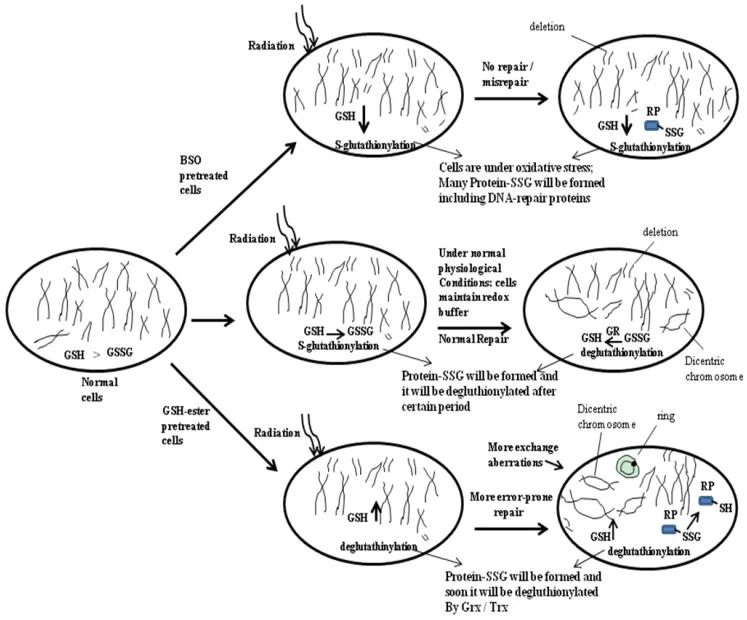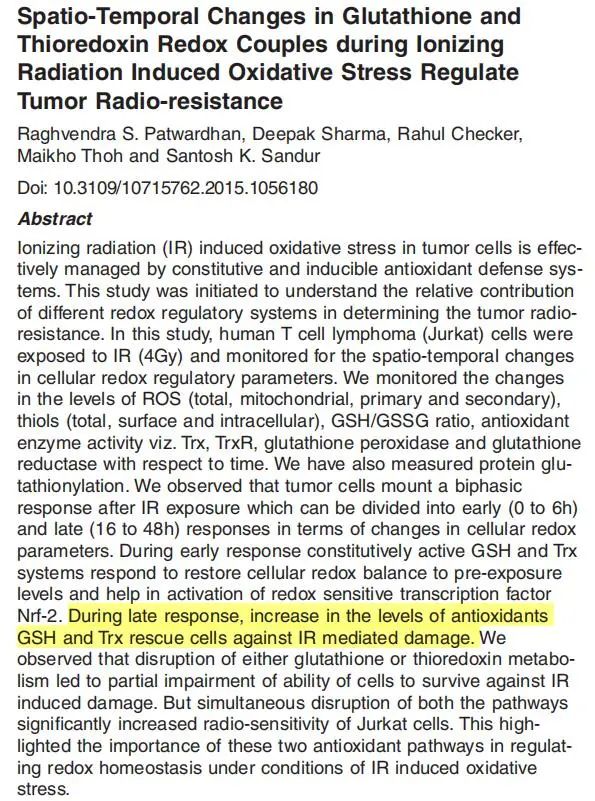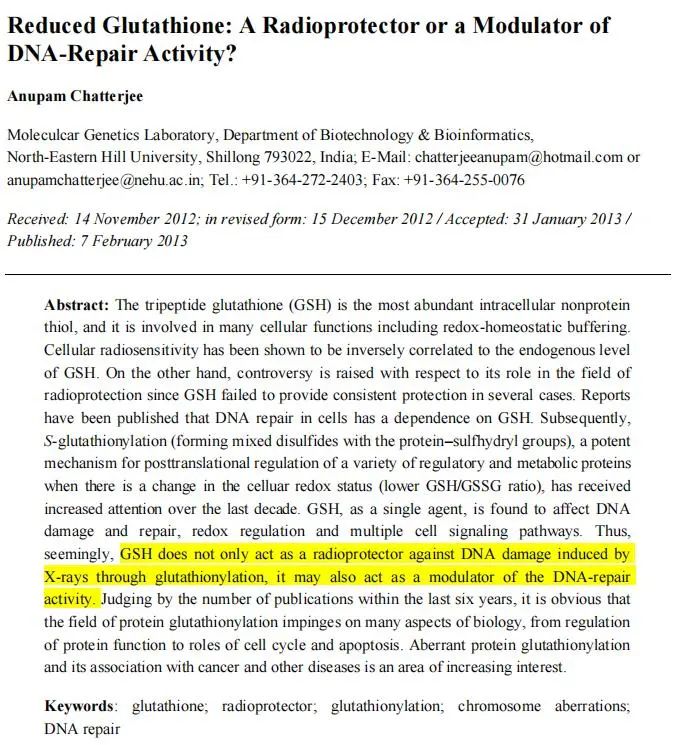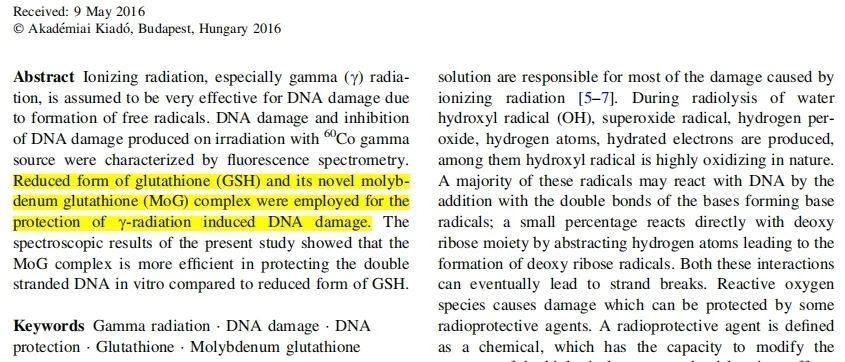Glutathione (GSH) is the most abundant intracellular non-protein mercaptan, which is involved in many cellular functions, including REDOX homeostasis buffering.
Cellular radiosensitivity has been shown to be inversely correlated with endogenous glutathione levels. Many experiments have investigated the potential role of GSH as a protective agent against cell damage caused by radiation or foreign chemicals, and as an antioxidant, GSH is also considered a radiation protective agent.

01 What are the dangers of Japan’s nuclear water discharge?
On August 24, 2023, Japan officially discharged the Fukushima First nuclear power plant nuclear sewage into the sea, the nuclear contaminated water contains up to 64 kinds of nuclear radioactive elements, and more than 70% are exceeded, and it is difficult to completely dispose of the multi-nuclide equipment.
According to the Woods Hole Oceanographic Institution in the United States, the nuclear sewage contains iodine-129, strontium-90, ruthenium-106, carbon-14 and other radioactive elements.
The levels of radioactive material in the Fukushima contaminated water are dangerously high and potentially damaging to human DNA. Among them, iodine-129 can cause thyroid cancer, and strontium-90 is included in the list of a class of carcinogens by the World Health Organization, which is prone to leukemia.
“Human beings are at the top of the food chain pyramid,” Liu Entao, from the School of Oceanology at China University of Geosciences, said. “Radioactive elements enriched by organisms such as seafood will affect human beings through the food chain.”
According to the analysis, humans ingest various radioactive isotopes in seawater indirectly through eating seafood. Experiments have shown that long-term, large-scale consumption of radioactive contaminated seafood may cause the accumulation of radioactive substances in the body to exceed the allowable amount, causing chronic radiation disease and other diseases, resulting in blood organs, endocrine system, nervous system and other damage.
The discharge of nuclear sewage will affect the waters along Japan’s Pacific coast, especially the local waters around Fukushima Prefecture, and then pollute the East China Sea. Japan’s neighbors will inevitably be affected.
A German Marine research institute said it would take 57 days from the date of release for the radioactive material to spread across most of the Pacific Ocean, and three years later the United States and Canada would be affected.
Taking radioactive cesium as an example, the Japanese Atomic Energy Research and Development Agency has carried out a computer simulation of the diffusion of radioactive cesium with a half-life of about 30 years, and found that it will reach North America in 5 years along the ocean current. The ocean currents will return to eastern Asia in the next decade; In 30 years, it will have spread almost across the Pacific.

02 Radiation preservative
Nuclear radiation refers to different energy particles and electromagnetic radiation released in the nuclear reaction process of atoms, such as fission and decay, whose action on substances can cause ionization and excitation, resulting in biological effects, so it belongs to ionizing radiation, radioactive material is one of the sources of nuclear radiation.
Ionizing radiation has direct, measurable harmful effects on cells, including an increase in reactive oxygen species (ROS) and the production of single-stranded DNA breaks (SSB) and double-stranded DNA breaks (DSB).

Since it recognized that ionizing radiation may cause damage to biomolecules, developments in the field of radiation protection are indeed closely related to the use of ionizing radiation.
For a reagent to act as a radiation protection agent, it must be present at the time of radiation to compete with free radicals produced by free radical scavenging mechanisms.
It well known that radiation protection agents can exert general antioxidant activity in addition to their ability to scour free radicals.
Radiation protectants may reduce carcinogenesis and teratogenesis through their effects on DNA damage, lipid peroxidation, protein damage, and cell cycle regulation.

Cell exposure to ionizing radiation leads to the production of reactive oxygen species,
which leads to the depletion of the cell’s antioxidant reserves, the most significant of which is GSH.
Multiple roles of glutathione GSH in cells
1 Antioxidant function
The antioxidant function of GSH expressed through direct interaction with reactive oxygen species or by providing electrons to other REDOX systems, such as glutathione peroxidase (GPX) and gludoxin (GRX).
2 Detoxification function
In addition to antioxidant and electron supply, GSH required to maintain homeostasis in animals,
such as detoxification by forming conjugations with poisons and inhibiting apoptosis.
3 DNA repair function
DNA double-strand breaks caused by ionizing radiation are serious damage that,
if unrepaired or repaired incorrectly, can lead to chromosomal aberrations, cell death, and mutations and cell transformations. It has shown that GSH may an important determinant of cells’ ability to repair DNA damage and resist cell death.
4 Radiation protection function
Traditionally, GSH in the nucleus has considered a protective agent for DNA and DNA-binding proteins from oxidative stress and radiation-induced damage,
and studies have shown that exogenous addition of GSH can effectively reduce radiation-induced micronucleus and chromosome aberrations in different systems.
GSH plays an important role in preventing DNA damage caused by oxidants and ionizing radiation,
as well as preserving nuclear proteins in a reductive environment for gene transcription during cell cycle progression.
Published reports have shown that DNA repair in cells is dependent on GSH. As a single drug, GSH has found to affect DNA damage and repair, REDOX regulation, and multiple cell signaling pathways.
Glutathione studies prove
Several studies have demonstrated that GSH can not only act as a radiation protection agent to prevent DNA damage,
but also as a regulator of DNA repair activity.



About GSH Bio-Tech
We offer high quality raw materials of reduced glutathione (GSH), acetyl-glutathione (SAG), β-nicotinamide mononucleotide (NMN) and Citicoline sodium (CDPC-Na).
Gudbio committed to the innovation and development of high value-added apis, important pharmaceutical intermediates and cosmetic raw materials. The production technology of glutathione and β-nicotinamide mononucleotides developed by GUDbio is internationally leading. If you are interested in our products, please contact us.
- The content of this article is provided as information only, does not represent the position and recommendations of the Department, and is not a substitute for medical diagnosis and recommendations.
reference
- [1] Patwardhan RS, Sharma D, Checker R, Thoh M, Sandur SK. Spatio-temporal changes in glutathione and thioredoxin redox couples during ionizing radiation-induced oxidative stress regulate tumor radio-resistance. Free Radic Res. 2015 Oct;49(10):1218-32. doi: 10.3109/10715762.2015.1056180. PMID: 26021764.
- [2] Chatterjee A. Reduced glutathione: a radioprotector or a modulator of DNA-repair activity? Nutrients. 2013 Feb 7;5(2):525-42. doi: 10.3390/nu5020525. PMID: 23434907; PMCID: PMC3635210.
- [4] Selim, M., Saha, A. & Mukherjea, K.K. Protection of radiation induced DNA damage by a newly developed molybdenum complex. J Radioanal Nucl Chem 311, 189–193 (2017).
- [5] Protein oxidative damage and redox imbalance induced by ionising radiation in CHO cells Donatella Pietraforte, Eleonora Paulicelli, Clarice Patrono, Lucrezia Gambardella, Giuseppe Scorza, Antonella Testa, Paola Fattibene. (2018) . Free Radical Research 52:4, pages 465-479.
- [6] Dannenmann B, Lehle S, Hildebrand DG, Kübler A, Grondona P, Schmid V, Holzer K, Fröschl M, Essmann F, Rothfuss O, Schulze-Osthoff K. High glutathione and glutathione peroxidase-2 levels mediate cell-type-specific DNA damage protection in human induced pluripotent stem cells. Stem Cell Reports. 2015 May 12;4(5):886-98. doi: 10.1016/j.stemcr.2015.04.004. Epub 2015 Apr 30. PMID: 25937369; PMCID: PMC4437487.
- [7] Tsutomu Shimura and others, Radiation affects glutathione redox reaction by reduced glutathione peroxidase activity in human fibroblasts, Journal of Radiation Research, Volume 63, Issue 2, March 2022, Pages 183–191
- [8] Khurana H, Hazari PP, Mishra AK. Radioprotective efficacy of GSH based peptidomimetic complex of manganese against radiation induced damage: DT(GS)2Mn(II). Free Radic Biol Med. 2019 Dec;145:161-174. doi: 10.1016/j.freeradbiomed.2019.09.023. Epub 2019 Sep 21. PMID: 31550530.
- [9] Ghoshal N, Sharma S, Banerjee A, Kurkalang S, Raghavan SC, Chatterjee A. Influence of reduced glutathione on end-joining of DNA double-strand breaks: Cytogenetical and molecular approach. Mutat Res. 2017 Jan;795:1-9. doi: 10.1016/j.mrfmmm.2016.10.005. Epub 2016 Nov 9. PMID: 27883910.




